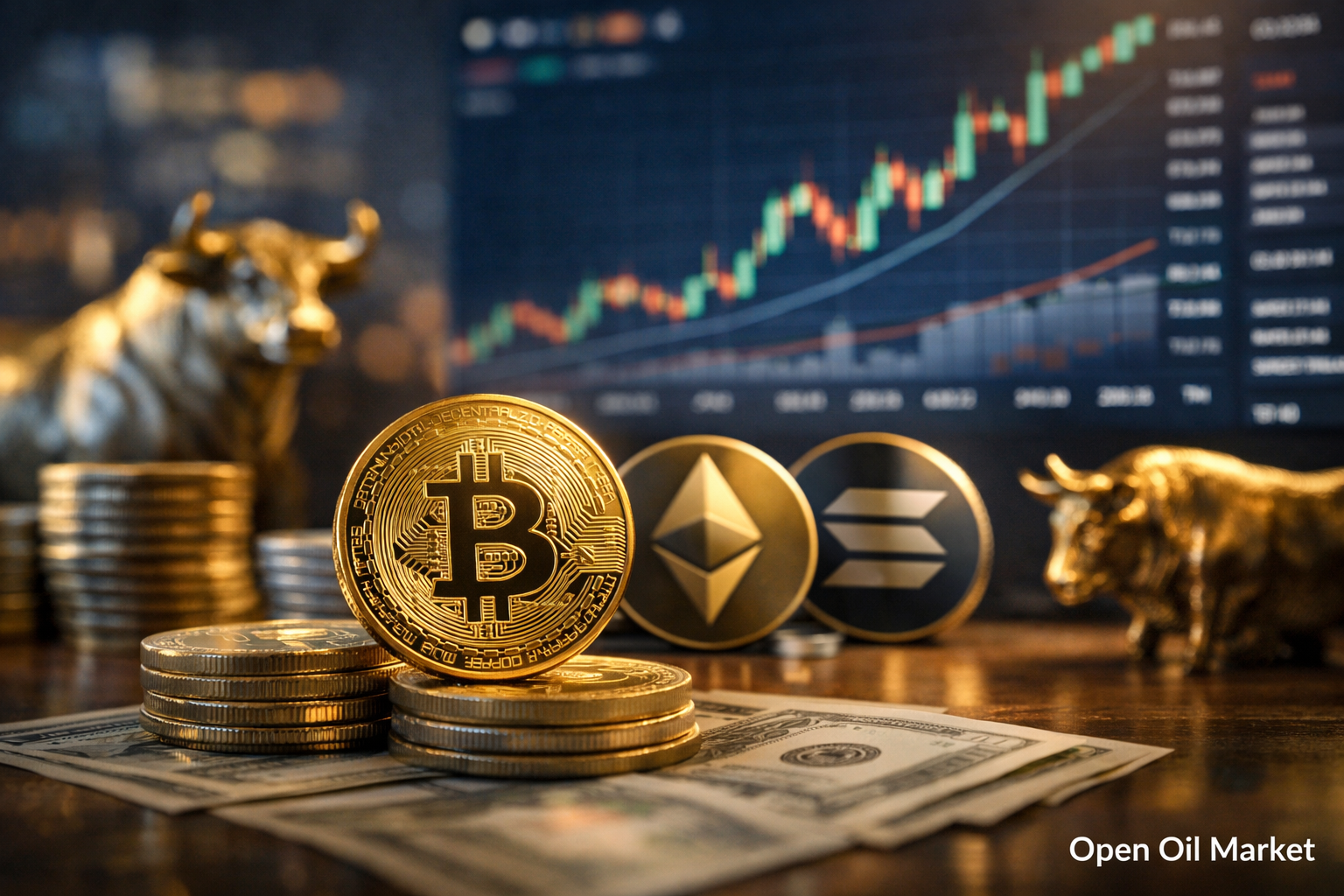
Latest Cryptocurrency News as of October 20, 2025: Market Attempts to Recover after Correction, Bitcoin Consolidates Above $100K, Ethereum Aims for $4K, Altcoins Bounce Back, Anticipation Surrounds XRP ETF Decision, Analysis of Top 10 Coins
As of the morning of October 20, 2025, the cryptocurrency market is showing a cautious recovery following a recent period of heightened volatility. After a rapid rally and subsequent sharp correction last week, the prices of digital assets have stabilized and begun to rise gradually. Bitcoin is holding above the psychologically significant level of $100,000, supporting the recovery of overall market capitalization (approximately $3.8 trillion). Following the flagship cryptocurrency, Ethereum and most leading altcoins are also strengthening. Investors are gradually returning to the market amid a reduction in external risks and the anticipation of positive news, such as regulatory decisions regarding exchange-traded crypto funds (ETFs). However, sentiment remains cautious: market participants are closely monitoring macroeconomic factors and regulatory signals, maintaining a balance between greed and fear.
- Cryptocurrency market capitalization: ≈ $3.8 trillion
- Bitcoin dominance: ~58%
- Fear and Greed Index: 30 (fear)
Market Overview: Stabilization After Correction
Following a turbulent week influenced by external factors, the cryptocurrency market is gradually stabilizing. The total market value of digital assets, which fell more than 12% from the peak values of early October, has started to recover. Bitcoin has regained some of its lost positions, pulling other coins in the top 10 along with it. Volatility remains elevated by historical standards, although it has notably decreased compared to the peak of the sell-off. The Crypto Fear & Greed Index, which dipped into the "extreme fear" zone, has risen closer to neutral levels, reflecting cautious optimism among investors. The volume of forced liquidations of margin positions has also decreased to moderate levels, indicating a subsiding of panic in the market.
The improving situation has been aided by a partial reduction in external risks. Tensions in trade relations between the U.S. and China, which triggered asset sell-offs in early October, have somewhat eased following more conciliatory statements from Washington. This has provided investors with a respite, and by the weekend, the prices of Bitcoin and Ethereum rebounded from local lows. Nevertheless, market participants remain on guard: any new wave of negative news—be it macroeconomic surprises or geopolitical events—could once again heighten volatility in the short term.
Bitcoin Consolidates Above $100K
The flagship cryptocurrency, Bitcoin (BTC), maintains a key level, consolidating around $110,000 following a recent correction. Earlier in October, BTC reached an all-time high of approximately $126,000, but the market then experienced a downturn that brought prices down by around 15%. Currently, Bitcoin has recouped some losses, trading nearly 5% above its recent lows, which bolsters participant confidence. BTC’s market capitalization exceeds $2.2 trillion, accounting for more than half of the overall cryptocurrency market capitalization.
Analysts note that the strong hold above the $100,000 mark signals the potential formation of a local "bottom" following the correction. Bitcoin's network metrics continue to improve: total hash rate is close to record levels, reflecting unwavering optimism among miners. On-chain data indicates that long-term holders have taken advantage of the price dip to accumulate BTC—balances on major addresses have increased despite sell-offs from short-term traders. At the same time, macroeconomic factors continue to influence dynamics: rising bond yields and a record spike in gold prices have temporarily diverted some capital towards traditional assets. However, as the situation stabilizes, Bitcoin is once again perceived as "digital gold," capable of serving as a protective asset. In the coming days, a key target for bulls will be to break the resistance around $120,000, while bears will attempt to push prices below $110,000, aiming to return the market to a declining phase.
Ethereum Regains Ground
Following Bitcoin, the second-largest cryptocurrency, Ethereum (ETH), is also exhibiting strength after a pullback. In early October, Ethereum surged nearly to $4,500 (just shy of its all-time highs in 2021), but the market's decline pushed the price below $4,000. By the end of last week, ETH had fallen to approximately $3,900, but since then it has recovered and is currently trading around $4,050. This price is about 10% below its recent local peak but more than double the levels from a year ago, reflecting the asset's long-term growth. Ethereum's market share has stabilized around 13% of total market capitalization, confirming ETH's status as the largest altcoin.
Despite price fluctuations, the fundamental metrics of the Ethereum network remain strong. The blockchain continues to process a high volume of transactions, with hundreds of thousands of addresses remaining active daily (over 600,000 per day). More than 35 million ETH (about 30% of the total supply) are engaged in staking since the network's transition to a Proof-of-Stake algorithm, indicating investor confidence in the project's long-term development. Ethereum retains a critical role in decentralized finance (DeFi) and NFT ecosystems—even amid price declines, interest in the smart contract platform remains strong. Anticipated technological upgrades aimed at improving network scalability and reducing transaction costs also support a positive outlook on Ethereum. Many experts believe that as overall market sentiment improves, ETH has the potential to continue an upward trend and approach its historical peaks.
Altcoins: Attempting a Rebound
The broader altcoin market is striving to regain lost ground after a widespread decline. Last week, many large altcoins dropped 15–20% from their highs, but with the easing of panic, most have entered a recovery phase. In recent days, leading altcoins have risen by 3–7%, reflecting an initial rebound. However, the dynamics remain uneven: some projects have recouped a significant portion of their downturns (for example, Solana (SOL) is holding around $190 again, while Binance Coin (BNB) is above $1,100), while others are seeing more modest increases. Tokens that were particularly hard hit during the correction, such as Cardano (ADA) and Dogecoin (DOGE), remain about 15% below their autumn peaks despite a slight bounce. Overall, investors are selectively returning to the altcoin sector, paying attention to fundamentally strong projects, while more speculative coins are still under pressure from caution.
XRP in Focus: Anticipation Surrounds ETF Decision
One of the market's key newsmakers remains XRP, the token from Ripple. After Ripple's legal victory over the SEC in the U.S. during the summer of 2025, when the court confirmed that secondary sales of XRP do not violate securities laws, interest from large investors in XRP significantly increased. At the peak of the rally in early autumn, XRP surged to approximately $3.00, briefly returning to the top three by market capitalization. However, during the recent correction, the token's price dropped about 20%—currently, XRP is trading around $2.40, and its market capitalization is roughly $130 billion (6th among cryptocurrencies).
Now, the market's attention is focused on the anticipated decision from the U.S. Securities and Exchange Commission (SEC) regarding the first spot ETF tied to XRP. Investment firm Grayscale has applied to convert its XRP trust into an exchange-traded fund, and analysts predict that the regulator will make a decision in the coming weeks. Approval of such an ETF would be a historic step—this would be the first time the U.S. regulator allows a fund based on a cryptocurrency outside of the BTC/ETH duo to be traded on an exchange. This could open access to XRP for a broader range of institutional investors and potentially provide a boost to the asset's value. The market currently reflects cautious optimism: experts assess the chances of a positive decision as quite high, considering the SEC's softened position following the successful launch of a Bitcoin ETF.
Ahead of the ETF verdict, volatility in XRP has increased. Trading volumes for the token are rising as traders try to predict the outcome: some players are positioning themselves with the expectation that XRP will rise if the fund is approved. If the SEC gives the green light to the XRP ETF, the market may see a new influx of institutional capital and a sharp price jump. Conversely, in the case of further delays or a rejection, short-term pressure on XRP's price is not ruled out, although long-term holders are likely to continue believing in the project due to the clarified legal status of the token.
Top 10 Most Popular Cryptocurrencies
- Bitcoin (BTC) – the first and largest cryptocurrency, akin to "digital gold." Price ~ $110,000; capitalization > $2.2 trillion (≈58% of the market). BTC sets the tone for the entire cryptocurrency market and attracts both retail and institutional investors.
- Ethereum (ETH) – the second-largest digital asset by capitalization, the primary platform for smart contracts and DeFi. Price ~ $4,050; capitalization around $480 billion (≈13% of the market). Ethereum powers hundreds of decentralized applications and continues to evolve, enhancing network scalability.
- Tether (USDT) – the largest stablecoin pegged to the U.S. dollar at a 1:1 ratio. Trading at $1.00; capitalization around $80 billion. USDT serves as a crucial source of liquidity in the cryptocurrency market, widely used for trading and settlements between various assets.
- Binance Coin (BNB) – the token of the largest crypto exchange Binance and the native token of the BNB Chain. Price ~ $1,100; capitalization around $170 billion. BNB is used for fee payments, participation in token sales, and various DeFi services within the Binance ecosystem, remaining one of the most valuable altcoins.
- USD Coin (USDC) – the second most significant stablecoin, backed by U.S. dollar reserves (issued by Circle). Price $1.00; capitalization ~ $30 billion. USDC is known for its high transparency of reserves and is widely used by institutional investors and DeFi protocols for secure entry into digital assets.
- Ripple (XRP) – cryptocurrency of the Ripple payment network, focused on global bank transfers. Price ~$2.40; market capitalization around $130 billion. After Ripple's court victory, interest in XRP increased; the token remains among market leaders, offering fast and low-cost transactions.
- Solana (SOL) – high-speed next-generation blockchain for decentralized applications. Price ~ $190; capitalization around $70 billion. The Solana ecosystem is recovering after a recent correction and continues to attract developers and investors (DeFi, NFT). Expectations for the launch of an ETF on SOL have also increased interest in the token.
- Cardano (ADA) – a smart contract platform with a scientifically-oriented approach to development. Price ~ $0.65; capitalization ~ $23 billion. The Cardano team regularly implements technological upgrades (e.g., the Hydra scaling protocol), and a broad community coupled with plans to launch investment products gives the token the status of a promising asset.
- Dogecoin (DOGE) – the most famous "meme" cryptocurrency, initially created as a joke. Price ~ $0.19; capitalization ~ $28 billion. DOGE remains in the top ten largest coins thanks to its dedicated community and periodic celebrity attention. Despite high volatility, the coin demonstrates remarkable resilience in investor interest.
- Tron (TRX) – a blockchain platform oriented towards the entertainment industry. Price ~ $0.32; capitalization ~ $29 billion. Tron is characterized by high throughput and widespread use for launching stablecoins (a significant portion of USDT circulates in its network). Staking factors help it maintain its position among market leaders, especially given the popularity of TRX in Asia.
Regulation and Macroeconomics
Regulators worldwide continue to shape favorable conditions for the crypto industry, strengthening investor confidence. In the European Union, a comprehensive regulatory framework known as MiCA is set to come into force, establishing unified rules. In the U.S., following the successful launch of a Bitcoin ETF, decisions are being prepared for new funds (Ethereum, XRP, etc.), and legislative initiatives to define the status of digital assets are being discussed. In several countries (UAE, Hong Kong, and others), crypto-friendly licensing regimes are being implemented, attracting innovative companies and capital. At the same time, the macroeconomic situation remains a significant factor impacting the market. Easing of monetary policy (e.g., signals from the Federal Reserve regarding interest rate cuts amid slowing inflation) could enhance risk appetite and support demand for cryptocurrencies. Conversely, tough rhetoric from central banks or escalation of geopolitical conflicts may temporarily cool interest in risk assets. In the long run, a combination of clear regulatory rules and a conducive macro environment will serve as a powerful driver for further growth in the cryptocurrency market.
Market Outlook: Cautious Optimism
Despite having faced upheavals, the long-term trend in the cryptocurrency market remains upward. Fundamental factors—limited Bitcoin supply, increasing institutional involvement, and technological advancements in blockchain—continue to support bullish sentiment. Major financial institutions are revising their forecasts: for example, Standard Chartered Bank recently raised its target for BTC to $200,000 by the end of 2025. While the path to new all-time highs may be uneven (with potential consolidation and short-term pullbacks in the coming weeks amid external factors), strategic investors view the current correction as a healthy pause in a larger growth cycle. Analysts recommend a balanced approach—diversifying portfolios and avoiding excessive leverage—to mitigate risks in a lingering volatile environment. Nevertheless, should positive macro trends and regulatory advancements persist, the majority of analysts expect key cryptocurrencies to reach new historical peaks in the coming quarters. Upcoming events—from new ETF launches to technological updates—could serve as catalysts for the next significant market uptrend.




